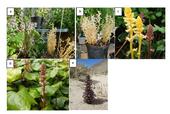- Author: Pershang Hosseini
- Author: Alison Colwell
- Author: Bradley Hanson
- Posted by: Gale Perez

The Orobanchaceae family comprises 270 holoparasitic species that cannot photosynthesize. Instead, they rely entirely on the host plant roots for nutrition, and can produce great numbers of minute, dust-like seeds that last for years in the soil. This family contains some of the most serious agricultural parasites in the genera of Phelipanche and Orobanche some of which are present in California. The different species can be distinguished by the degree of branching of their stems and presence/absence of bracteoles at the base of the flower Orobanche species have unbranched stems and no bracteoles, while Phelipanche species feature branched stems with bracteoles. In this paper, we discuss three...
- Author: Trina Kleist
- Posted by: Gale Perez

Auto emissions 'fertilize' fuel
Joshua trees burning in the Mojave Desert are the victims of changing patterns of wildfire, fueled by the spread of grasses that are not native to the region, restoration ecologist Justin Valliere told media in recent interviews.
In late July, Valliere was still settling into his new job at the Department of Plant Sciences when the York Fire erupted in the Mojave National Preserve in southern California. The area includes the western range of the Joshua tree, a unique type of yucca that has...
- Posted by: Gale Perez

Anil Shrestha (Weed Science Professor, with the Department of Plant Science at CA State University, Fresno) will be speaking at the Association of Applied IPM Ecologist (AAIE) Annual Conference in Visalia, CA. His talk on "Managing weeds in an IPM program. Ecology plays a big part." is scheduled for Nov. 7, 2023.
Visit the AAIE website for information on the conference: https://www.aaie.net/events2.
AAIE conference agenda attached.
- Posted by: Gale Perez

The East Bay Regional Park District is currently recruiting for two (2) Vegetation Ecologists and these positions will be headquartered at the Park District's Administrative Office, 2950 Peralta Oaks Ct., Oakland. The hiring pools established from this recruitment will be used to fill the current vacancies and additional vacancies that may occur during the one-year life of the hiring pools. Up to 50% of the time will be working in the field between Alameda and Contra Costa County.
One (1) position is housed within the Integrated Pest Management Program and will focus on noxious weed management in range and grasslands, Early...
- Author: Ryan Hill

My name is Ryan Hill, and I am the new UC Cooperative Extension Weed Science and Agronomy Advisor in Tehama County, also serving Shasta and Glenn counties. I received a B.S. in Biology from George Fox University in 2014 and an M.S. in Plant Breeding and Genetics from the Department of Horticulture at Oregon State University in 2020. From 2020 to 2023 I was a Faculty Research Assistant in Dr. Marcelo Moretti's perennial weed science lab at OSU. In this role I conducted weed research in horticultural crops including several projects on herbicide-induced crop injury. Additional projects included electrical weed control of Italian ryegrass, sucker control in hops and hazelnuts, pollinator habitat establishment with pre-emergent herbicides,...


